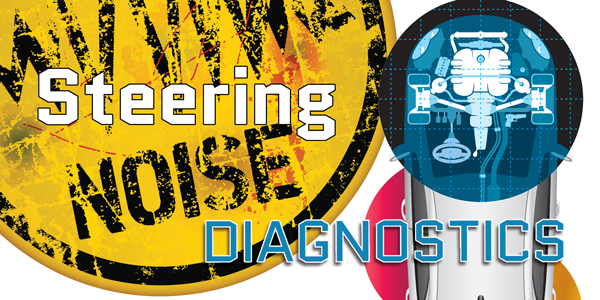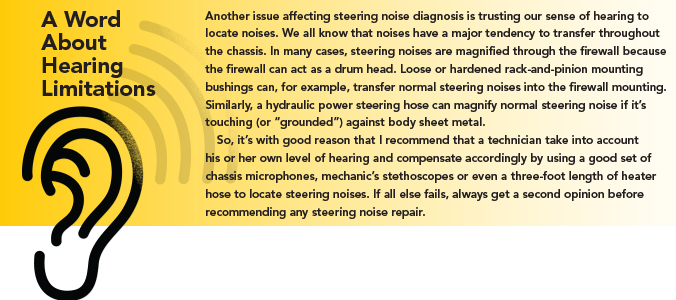Steering system noise complaints can often be difficult to reproduce and diagnose. A squeaking noise in the steering column, for example, can often be influenced by temperature and humidity. In other cases, a squeaking noise can be caused by dry or corroded universal joints in the steering intermediate shaft located between the steering shaft and the steering gear or rack. Or, it can be caused by two pieces of trim plastic rubbing together, which can easily be remedied by applying a small amount of aerosol silicone or silicone grease on the offending surfaces (See Photo 1).
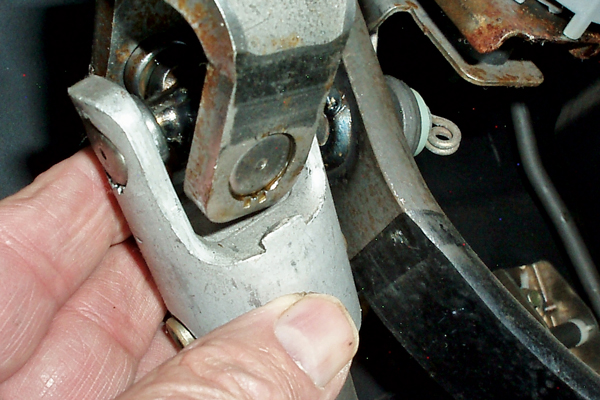
Any plan of attack on steering noise should always include the vehicle manufacturer’s TSBs (Technical Service Bulletins) and recalls. If all else fails, the best source of information concerning intermittent steering noises can often be found on the internet by searching the vehicle’s nameplate and “steering noises.” You’ll find a lot of input from both amateur and professional mechanics. For example, some 2007 and later Toyota RAV4s might be plagued with an odd “clunking” noise emanating from the steering column.
While I don’t approve of all these recommended fixes, many of these case studies will help the professional technician verify the customer’s complaint and identify the source of the “mysterious” noise. The fix I found for the RAV4 in question was using a hypodermic needle to squirt a drop or two of gun oil past the slip joint shaft seal.
Road Surface and Steering Noises
Since many steering system noises are apparent only when driving on uneven surfaces, it pays to thoroughly interview the driver about the conditions under which the noise occurs. A low-frequency “chucking” noise coming through the steering wheel during a low-speed test drive over tar strips or washboard road surfaces can often be caused by loose front stabilizer bushings, worn flexible steering couplers or worn inner tie rod ends on rack-and-pinion steering.
On rare occasions, a rattling or chucking noise can be caused by wear in the slip joints built into collapsible steering columns. Steering shaft noises can occasionally be reproduced by lightly rocking the steering wheel or front wheels back and forth with the vehicle suspended on a lift (See Photo 2).
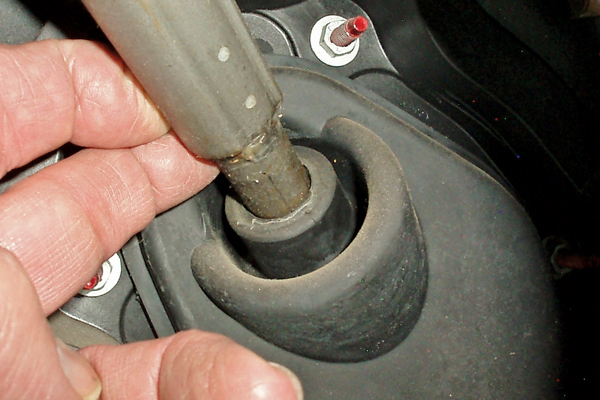
Hydraulic Steering Diagnostic Tips
Air entering a steering pump inlet can cause cavitation that, in turn, causes an irritating buzzing noise in the steering. To better understand, a hydraulic power steering pump is comprised of a vane- or roller-type pump in which the pressure output is controlled by a hydraulically controlled boost valve. When no steering assist is required, a torque-sensitive orbital valve located on the steering gear recirculates a low-pressure volume of fluid through the steering hydraulic system to purge air bubbles. As steering wheel torque increases, the orbital valve meters fluid flow to provide steering assist. The boost valve will respond by proportionately increasing steering pump pressure to turn the front wheels.
If the pump appears to lack sufficient assist, it means that the pump itself is worn out or the drive belt is slipping. Be aware that some drive belts can slip without producing a squealing noise. In some cases, wear in the boost valve will cause the steering pump to “buzz” when no assist is needed because the valve is vibrating against its seat. If the pump buzzes or howls as steering assist is applied, the pump could be ingesting air from the steering gear into the pump reservoir.
A few systems locate a filter screen in the return line that can easily be clogged by rubber from deteriorating hoses. In this case, again, pump cavitation occurs because fluid flow into the pump is restricted.
Last, but not least, some imports (like certain
Honda models) use a rubber O-ring to seal the inlet hose on the power steering pump. If that O-ring hardens through age, air bubbles can be ingested into the pump, which can cause the all-too-familiar whining or buzzing noise (See Photo 3).
Many imports like Honda use application-specific power steering fluids or automatic transmission fluid in their power steering systems. Unfortunately, some technicians might inadvertently top off a low or empty power steering reservoir on a Toyota with inappropriate fluids ranging from brake fluid to motor oil. If the fluid viscosity or appearance is suspect, I recommend thoroughly flushing the power steering system with the recommended fluid before attempting a noise diagnosis.
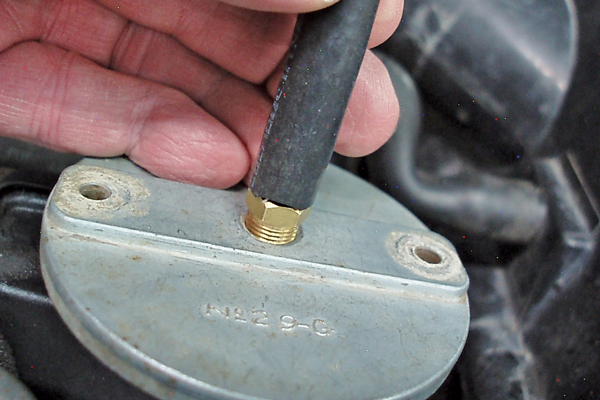
Belt-Related Steering Noises
A simple trick for diagnosing a belt-related chirping or squealing noise is to squirt a little water onto the serpentine belt. If the noise disappears, then it means it was being caused by either a belt-slippage or belt-tracking problem. Since modern serpentine belts are made from EPDM rubber, cracking or glazing problems have become nearly non-existent. Because the serpentine belt is formed over a rigid belt, it doesn’t adapt well to side-to-side variations caused by pulley misalignment.
For that reason, the V-grooves in the serpentine pulleys must track exactly parallel to each other to ensure full belt contact. Using a laser-type alignment tool from one of the major belt manufacturers to check pulley alignment will pay dividends when diagnosing cold-chirping noises, high-speed squeals and other difficult-to-duplicate serpentine belt issues.
Since we can’t visually estimate wear in an EPDM rubber belt, we can’t judge when a worn belt begins to slip. We should therefore use the wear gauges supplied by many belt manufacturers to measure the actual wear in the belt and the pulley itself. It’s also important to recognize that preload springs and bushings built into serpentine belt tensioners eventually wear out, which is why many steering squeal or rattling complaints can be traced directly to a weak or worn belt tensioner. For this reason, it’s important to include a new belt tensioner in the estimate when replacing water pumps and other belt-driven accessories on high-mileage engines.
Electric Steering Noises
Electronic/electric steering eliminates issues associated with hydraulic steering by using a reversible, pulse-modulated electric motor to provide steering assist. In brief, steering assist inputs to the steering module including vehicle speed, steering torque and steering wheel position. Keeping in mind that most of the noise issues in electric steering systems have been addressed by manufacturer recalls, remember that an occasional noise complaint can be caused by the relays located in the steering modules clicking as they open and close, or by the reversing action of the assist motor itself.
Other noises such as looseness in the steering slip joint, the lower column bushing or the adjustment of the steering shaft itself can create mild, but often irritating, noises. In some cases, these noises can be remedied, but many times not. In any case, a technician should always check his service information system for the latest TSBs or manufacturer recalls for steering systems of the specific vehicle.
Steering Linkage and Strut Noises
Last but not least, some creaking and groaning steering noise complaints on older import trucks are caused by the ball joints and steering linkage never being greased. It’s also common for the grease in a permanently lubricated ball joint, tie rod end or idler arm to be washed away if the rubber seal ruptures or if the vehicle is flood-damaged.
Vehicles equipped with full MacPherson strut front suspensions will, in many cases, require new upper support bearings because the lubricant simply dries out, leaving the bearing vulnerable to wear and corrosion. A creaking or moaning noise might also be caused by a seized or damaged steering dampener.
In any case, always keep an open mind when diagnosing “mysterious” steering linkage noises.
Adapted from an article in Import Car.

